Running News Daily
Running News Daily is edited by Bob Anderson. Send your news items to bob@mybestruns.com Advertising opportunities available. Train the Kenyan Way at KATA Kenya and Portugal owned and operated by Bob Anderson. Be sure to catch our movie A Long Run the movie KATA Running Camps and KATA Potato Farms - 31 now open in Kenya! https://kata.ke/
Index to Daily Posts · Sign Up For Updates · Run The World Feed
How much time do carbon shoes really take off?
Professor of biomechanics at BYU gives his perspective on the benefits of carbon-plated shoes.
Since Nike launched the original carbon-plated Nike Vaporfly, there has been a transition to the type of shoe runners are wearing. When the Vaporfly was released, it changed the game with a non-traditional look. Instead of being as lightweight as possible, the brands designed a bulkier shoe with lightweight foam plus a carbon plate to provide stiffness. When Eliud Kipchoge ran under 2:01 for Nike’s Breaking2 project, the carbon craze began.

Many runners saw the way the shoe benefited the world’s best marathoner and thought, “I wonder how fast a carbon shoe would make me?”
Easton Allred, a cross-country runner with Brigham Young University, discussed the recent development of carbon shoes with professor of biomechanics Dr. Iain Hunter, who studies how people can run faster by the way they move, and the effect of footwear on their athletic performance. The two discuss whether carbon is beneficial and how much time it could take off your 5 km.

Dr. Hunter notes that half the hype around carbon-plated shoes is psychological, and most runners won’t see a benefit from the plate itself. “A common misconception is that it acts as a spring – the plate is actually in the shoe to hold the foam together,” Hunter said. Each carbon shoe is very individualized and based on many variables. For example, if you are a heel striker, the plate/foam will not generate as much responsiveness for a forefoot striker. “I am convinced that the shoes help with performance, but I doubt it’s as big an effect as a lot of people think,” Hunter adds.
Allred asks, “How much of a difference do you think it would make in a 5 K race?”
“Maybe two or three seconds per kilometre,” Hunter states. “A couple of seconds could be very meaningful to some runners, but there isn’t more than that.” The technology of racing flats before carbon shoes wasn’t far behind, and runners were still breaking world records in flats.
“We have done studies that there are extreme benefits to recovery with carbon shoes, since the foam is softer than racing flats,” Hunter states
With the book out on the benefits of carbon shoes, all brands have adapted to the same technology. The only difference between models would be the softness of the foam and the stiffness of the plate.
by Marley Dickinson
Login to leave a comment




